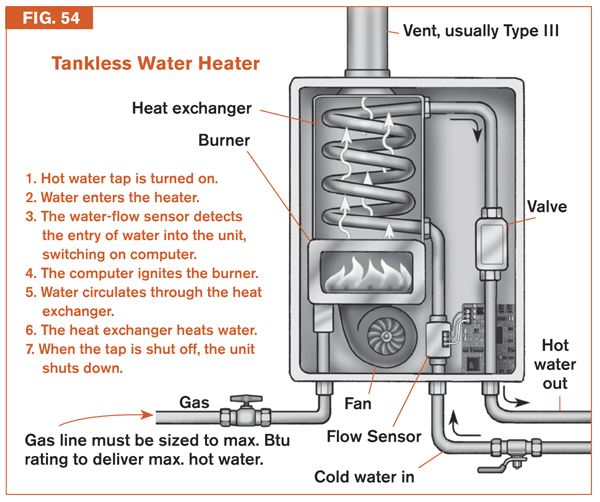Blog Post
Storage vs. Tankless Water Heaters

Last week I suggested some ways to reduce your hot water use. This is almost always the easiest way to save energy with water heating--it's the "low-hanging fruit" to be sure. Over the next few weeks, I'll get into water heating options. To start, let's look at the differences between "storage" and "tankless" water heaters.
The vast majority of homes have storage-type water heaters. There's an insulated tank and either a gas burner or electric heating element (often two elements) to heat the water. An advantage of storage water heaters is that you don't need a very large gas burner or a really high electric current flow to heat the water. The gas burner or element can chug along for hours, gradually warming up water in the tank. The water remains "thermally stratified" so that water drawn off from the top is always the hottest and even after 90% of the hot water is used up, the delivered water is still at full temperature. Storage electric water heaters also allow "off-peak" electricity to be used--more about this in a future column.
While storage water heaters are the most common, there's a lot of interest in tankless models--sometimes referred to as "on-demand" or "instantaneous" water heaters. The advantage of these is that you don't have water sitting all the time, losing energy through the tank walls. (Even with insulation, heat loss occurs.)
As with storage water heaters, tankless models can be either gas-fired or electric. For very small loads, such as with a remote lavatory that has only a sink (with a low-flow aerator), an electric tankless water heater can make a lot of sense since it obviates the need for running a gas line. But for whole-house needs--where a central water heater serves one or more bathrooms with showers, the kitchen sink, dishwasher, and clothes washer--a gas-fired tankless water heater is almost always a better choice than electric.
Providing enough electric current to instantaneously heat 4-5 gallons per minute (gpm), boosting the temperature more than 60 degrees F (as might be necessary if two showers are being used at the same time, or if a dishwasher or clothes washer is being used while someone is showering) would take a huge amount of electric current--on the order of 40 to 60 amps. Providing so much electricity would require special wiring and special circuit breakers, which are expensive. And from a big-picture standpoint, if a lot of people used these tankless electric water heaters, utility companies would have to build more power plants to have adequate electricity available during periods of time with high use of hot water, such as during the morning shower period. Utility companies love storage water heaters, because they spread out the demand.
If you decide to go with a whole-house, gas-fired (natural gas or propane) tankless water heater, be aware that because the burners on tankless water heaters are so large--150,000 to 200,000 Btu/hour, vs. 40,000 Btu/hour for a typical gas-fired storage water heater--larger-diameter gas lines are required (usually 3/4-inch instead of 5/8-inch). And to burn that much gas, a lot of air flow is required, which necessitates a large flue, and there is potential for significant air leakage if not properly installed.
SUPPORT INDEPENDENT SUSTAINABILITY REPORTING
BuildingGreen relies on our premium members, not on advertisers. Help make our work possible.
See membership options »Another issue with tankless gas water heaters is pilot vs. pilotless ignition. Tankless water heaters used to all have pilot lights, which burned gas all the time. The wasted energy from these pilot lights (about 5,000 Btu/hour) was about the same as the heat loss through the insulated walls of a storage water heater, so you didn't end up with much energy savings.
Most new tankless water heaters have electronic ignition, and if you're thinking of a tankless water heater I'd go with this option. The gas burner is ignited using an electrical spark. With pilotless ignition, today's gas-fired tankless water heaters offer the highest efficiency of any water heater, except heat-pump models, which I'll cover in a future column.
A few gas-fired tankless water heaters made by the Korean companies Takagi and Navien have "condensing technology" with an Energy Factor of up to 0.98 (Energy Factor is a measure of efficiency). Non-condensing, pilotless tankless water heaters have Energy Factors of .82 to .87, while conventional storage water heaters have energy factors of .58 to about .67 (up to .80 for condensing models).
So which is better: a storage or a tankless water heater? Despite the potential for higher efficiency with tankless technology, it will surprise a lot of my readers to learn that I'm partial to storage water heaters for most situations. They are less expensive, less prone to mechanical problems, and, with electric models, offer the potential for using off-peak electricity--which is significantly less expensive than propane. Storage water heaters also encourage thrift when showering, since there's a finite amount of hot water.
Published June 2, 2009 Permalink Citation
(2009, June 2). Storage vs. Tankless Water Heaters. Retrieved from https://www.buildinggreen.com/blog/storage-vs-tankless-water-heaters



Add new comment
To post a comment, you need to register for a BuildingGreen Basic membership (free) or login to your existing profile.